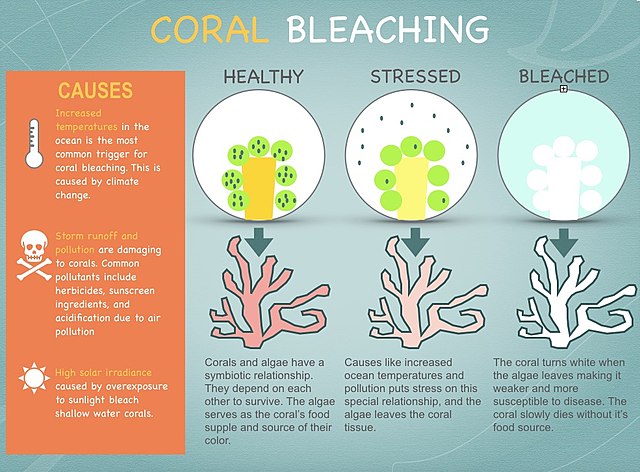A marine heatwave is a period of abnormally high ocean temperatures relative to the average seasonal temperature in a particular marine region. Marine heatwaves are caused by a variety of factors, including shorter term weather phenomena such as fronts, intraseasonal events, annual, or decadal (10-year) modes like El Niño events, and longer term changes like climate change. Marine heatwaves can have biological impacts on ecosystems at individual, population, and community levels. MHWs have led to severe biodiversity changes such as coral bleaching, sea star wasting disease, harmful algal blooms, and mass mortality of benthic communities. Unlike heatwaves on land, marine heatwaves can extend for millions of square kilometers, persist for weeks to months or even years, and occur at subsurface levels.
Bleached coral
Healthy coral
The marine heatwave termed "The Blob" that occurred in the Northeastern Pacific from 2013 to 2016.
Coral bleaching is the process when corals become white due to loss of symbiotic algae and photosynthetic pigments. This loss of pigment can be caused by various stressors, such as changes in temperature, light, or nutrients. Bleaching occurs when coral polyps expel the zooxanthellae that live inside their tissue, causing the coral to turn white. The zooxanthellae are photosynthetic, and as the water temperature rises, they begin to produce reactive oxygen species. This is toxic to the coral, so the coral expels the zooxanthellae. Since the zooxanthellae produce the majority of coral colouration, the coral tissue becomes transparent, revealing the coral skeleton made of calcium carbonate. Most bleached corals appear bright white, but some are blue, yellow, or pink due to pigment proteins in the coral.
Healthy coral
Bleached coral
Coral bleaching in ecosystems is a complex dynamic. Coral is able to slowly recover after experiencing bleaching, how ever it is a slow process which typically results in re-bleaching.
Coral and microscopic algae have a symbiotic relationship. When water temperatures get too high, the algae leave the coral tissue and the coral begins to starve.





